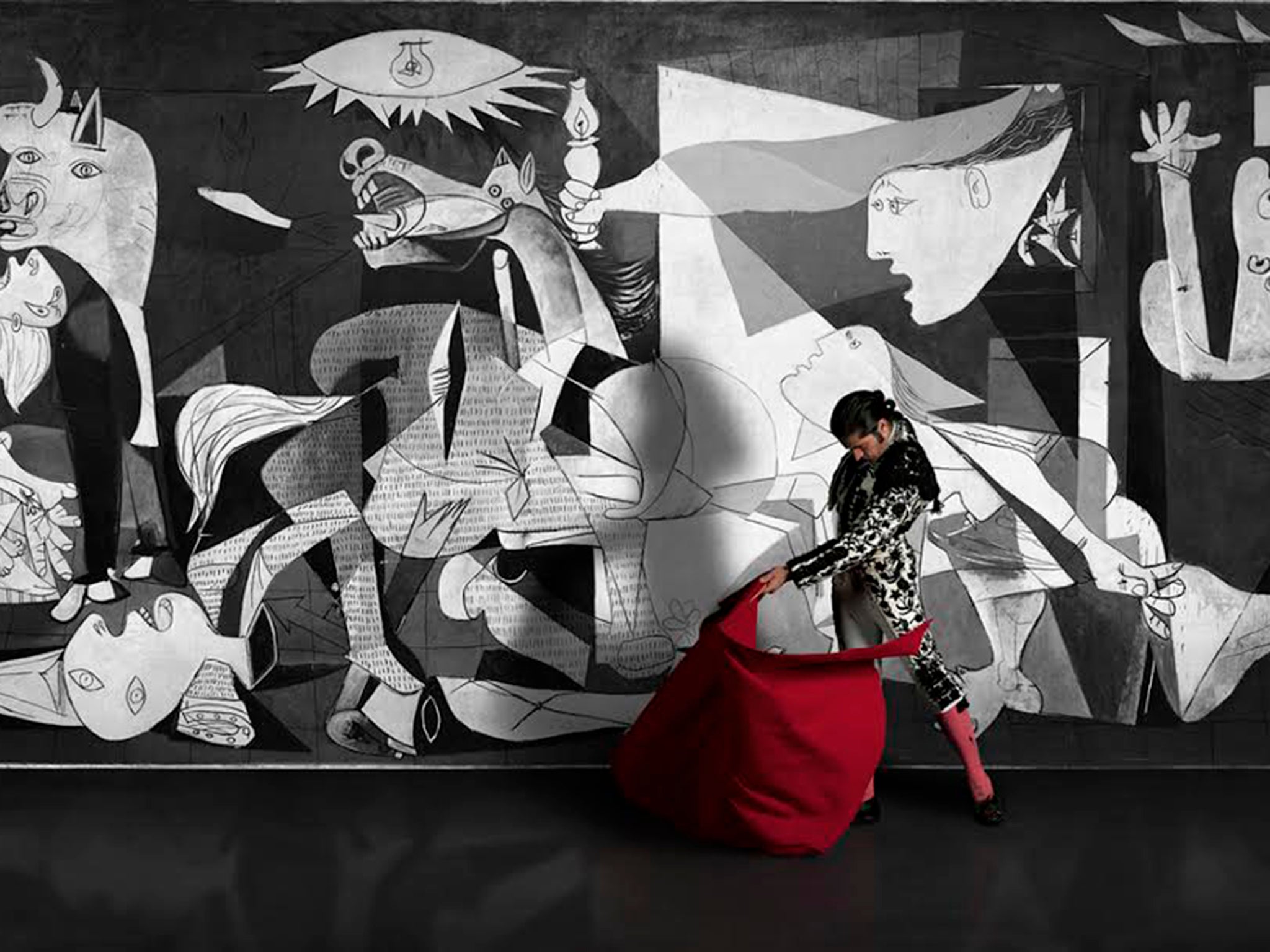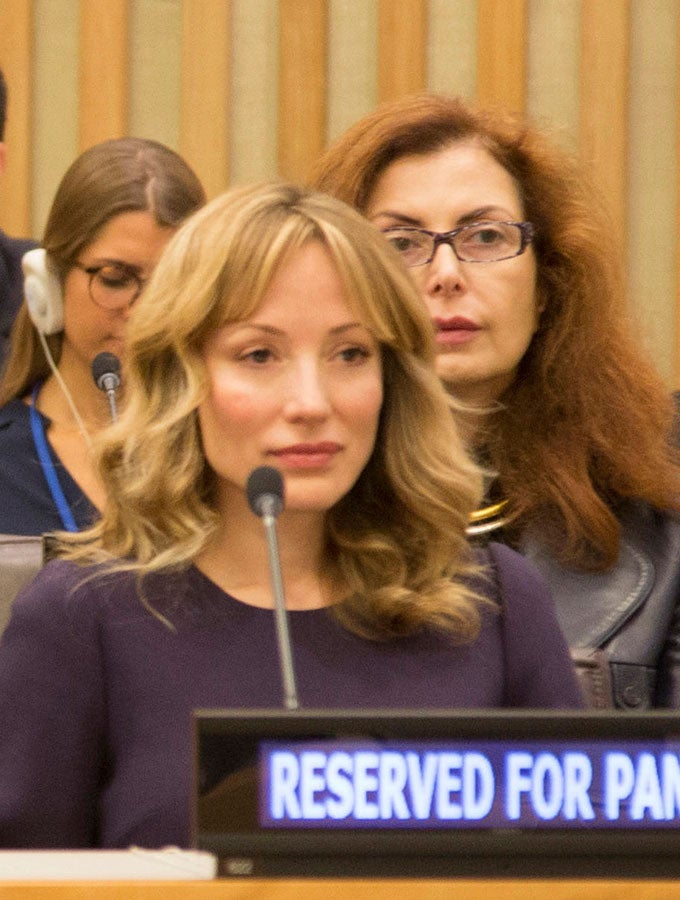Denise De La Rue interview: How Picasso inspired my film A Cry for Peace
De La Rue developed the idea for A Cry for Peace when she again saw Picasso's Guernica in the flesh in 2010. Image © Succession Picasso, 2014

When the mexican artist Denise De La Rue first saw Pablo Picasso’s 1937 anti-war masterpiece Guernica, as a 10-year-old girl visiting the Museo de Prado in Madrid in the early 1980s, it didn’t so much leave a lasting impression as ingrain in her a call to action.
“As a 10-year-old, I was not rational or intellectual but I saw the painting and thought, ‘one day I will do something with this’,” she recalls. “I just had this perception that I could do something about it in an evocative way.”
This childhood instinct came to pass in spectacular fashion for De La Rue last week when her short film A Cry for Peace premiered at the United Nations General Assembly meeting in midtown Manhattan. The three-minute film depicts a matador performing the danse macabre of bullfighting in front of Guernica that now hangs in the Museo Nacional Centro de Arte Reina Sofia in Madrid.
Guernica, considered by many to be Picasso’s finest artwork, dovetails effectively with A Cry for Peace. Among the many visions of suffering depicted in the mural-sized canvas, painted by Picasso in response to the bombing of the small Basque country town of Guernica by German bombers supporting General Franco in the Spanish Civil War, is a bull watching the human sacrifice unfold.
As with Picasso, for whom bullfighting was a frequent artistic subject, De La Rue, who now lives in New York City, has developed a strong following chronicling the matador in her work. Her pictures of modern bullfighting in Mexico City, where she was born and raised, and Madrid, have been shown throughout the USA and Latin America including at the Gagosian Gallery in Beverly Hills.
A Cry for Peace depicts the matador as a metaphor for the tragic soldier as he twirls his muleta (the small red cape on a stick that the bullfighter uses alongside his sword) to the sound of a darkly atmospheric score by Argentine Oscar-winning composer Gustavo Santaolalla.
Replicating Guernica’s themes, A Cry for Peace is a meditation on the suffering of war that also strikes a hopeful note that violent conflict will be less prevalent in the future compared with the past or present.
De La Rue views bullfighting as an ideal lens through which to observe the suffering and significance of war.
“I can see the dichotomy of human existence in bullfighting – the struggle between life and death, beauty and cruelty, a hero and a shadow,” she tells me when we meet at the Surrey Hotel in Manhattan the day before her film’s UN showing. “I’m captivated with bullfights and feel the pain when they kill the bull. But bullfighting also has this beautiful aesthetic to it.”
De La Rue developed the idea for A Cry for Peace when she again saw Guernica in the flesh in 2010. Yet there existed a not inconsiderable obstacle to her notion of filming in front of Guernica: the Picasso estate, headed by the artist’s only surviving son, Claude Picasso, had never previously sanctioned a contemporary artist to use the painting’s image in any artwork.
“They never said ‘no’,” she says of her early negotiations to film against the backdrop of Guernica. “They ignored me – no reply. I insisted and insisted. It took me a year-and-a-half to get the permission from the Picasso estate.” As passionate and articulate as De La Rue is, how did she manage to persuade them? “I think it’s a combination of persistence and luck. When they said ‘yes’, they didn’t know the results so they took a chance. They had to trust me blindfolded and I’m grateful for that.”

The renowned Spanish bullfighter Javier Conde, who appears in A Cry for Peace, was the next person De La Rue had to persuade to participate in her enterprise. “When I thought about doing this, the only matador I could think of doing this was him,” she says. Filming A Cry for Peace occurred in 2011 and took four hours. Because it had to be shot in one take, Conde wound up entering and exiting the space of Guernica 60 times in that time.
De La Rue’s formidable powers of persuasion then won over the UN. Although a tapestry copy of Guernica was displayed on the wall of the United Nations Building in New York at the entrance to the Security Council room from 1985 to 2009, A Cry for Peace being shown there represents the biggest cultural coup to take place within the global organisation’s walls since the film director Sydney Pollack shot The Interpreter, starring Nicole Kidman, inside the building a decade ago.
“When I finished it, I thought that the best place to premiere it was the United Nations instead of a gallery because I wanted it to show in a venue that reinforced the anti-war statement,” De La Rue says. A mutual friend put her in touch with Muna Rihani, Chair of UN Women for Peace and wife of the Qatari diplomat Nassir Abdulaziz Al-Nasser, who was president of the 66th session of the UN General Assembly. Al-Nasser now heads the UN Alliance of Civilisations that exists to use culture to promote unity and diversity, and which is the body that showed A Cry for Peace last Friday.
De La Rue herself addressed the UN General Assembly prior to the screening, calling for a reduction in global conflict: “I show you this film hoping that we may reflect upon our own light and our own darkness, hoping that we will re-awaken us to our own violence and our own peace and by embracing that contradiction we may transcend it.”
Among those gathered at the UN General Assembly to watch A Cry for Peace was the model Naomi Campbell. “I like Denise’s work,” she told The Independent. “I know some of it because Sharon Stone is a collector of Denise’s work. A Cry for Peace is very powerful. I would love for it to have been longer and I told her that but of course it’s an installation and it goes on a loop. It’s very graceful. He’s [Conde is] like a ballerina.” Campbell echoed De La Rue’s belief that art played an integral role in promoting international conciliation. “I travel constantly and if you stop and think about it, it’s very frightening the world we live in,” she says. “There has to be a resolution. It’s got to a point where everybody wants peace and that’s why it’s great that art is making a difference.” As for De La Rue, her future aspirations include showing in the UK. “I’ve never had a show in London but I love its magic and energy,” she says. “New York is the crazy teenager and London is the father!” She will shortly be filming a documentary on former war zones and there’s also a forthcoming project focusing on the Catholic Church.
“I’m going to leave bullfighting for the moment and my next series is going to be at the Vatican,” she reveals. “A bullfighter and a priest have many things in common – life, death and eternity. I love this Pope and I think the state of the church is interesting.” Having enlisted the UN and Picasso estate to support A Cry for Peace, I wouldn’t be at all surprised if Pope Francis personally ends up unveiling De La Rue’s completed work.
Join our commenting forum
Join thought-provoking conversations, follow other Independent readers and see their replies
Comments
Bookmark popover
Removed from bookmarks